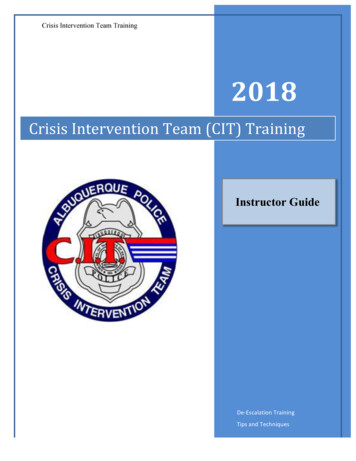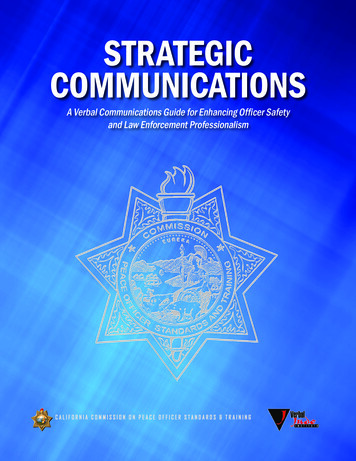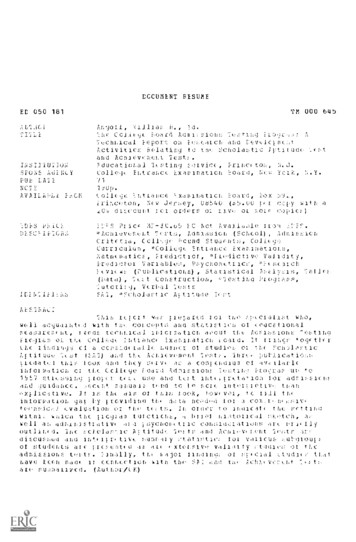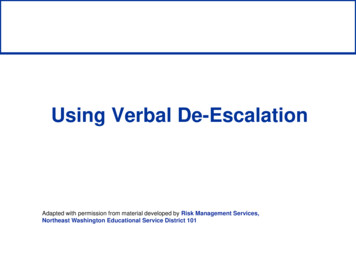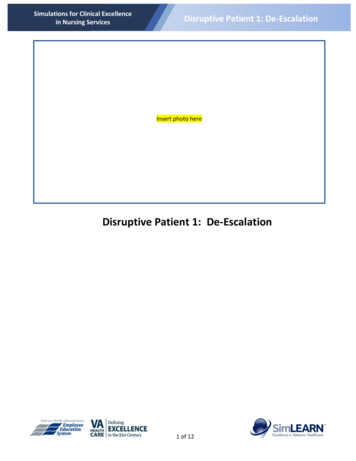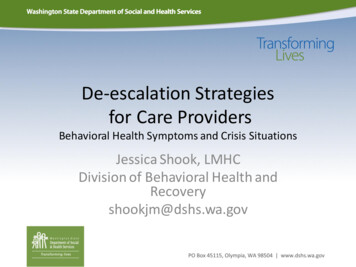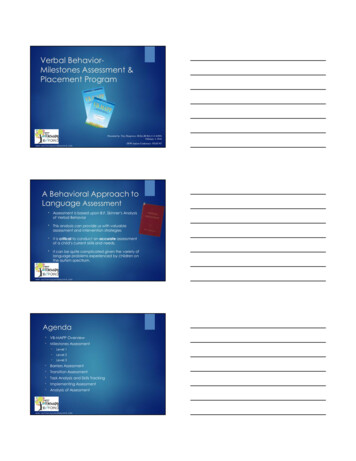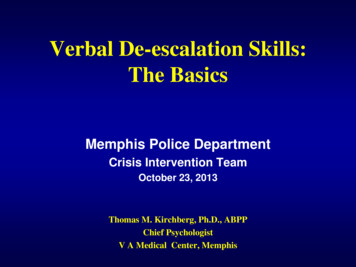
Transcription
Verbal De-escalation Skills:The BasicsMemphis Police DepartmentCrisis Intervention TeamOctober 23, 2013Thomas M. Kirchberg, Ph.D., ABPPChief PsychologistV A Medical Center, Memphis
Stages of anEscalatingCrisisAdvancedVerbal alSkillsWed PM (3)Thurs AM (1)Thurs AM (1)Thurs PM (5)Fri AM (3) hrsScheduling De-Escalation in the 40 Hour CIT Training
Stages of cVerbalSkillsBasic SkillsAdvancedVerbal ionStrategies
Plan of Learning1. Crisis, Intervention, Team2. Emotional Crises impose suffering3. Empathic understandingA. Active listening & Active observing1)2)3)4)5)Filter or “noise”Restatement & ReflectionExerciseQuestions“I” statements4. Genuineness5. Acceptance6. Skills practice
Plan of Learning1. Crisis, Intervention, Team2. Emotional Crises impose suffering3. Empathic understandingA. Active listening & Active observing1)2)3)4)5)Filter or “noise”Restatement & ReflectionExerciseQuestions“I” statements4. Genuineness5. Acceptance6. Skills practice
Crisis An emotionally stressful event ortraumatic change in a person’s life A point in a story or drama when a conflictreaches its highest tension and a solutionmust be found
Intervention To compel or prevent an action To maintain or alter a condition
Team A number of persons associated togetherin work or activity A group on the same sideasroma.itDoD photo by Staff Sgt. Jim Goodwin, U.S. Marine Corps.(Released)University of Memphis CIT Center
Photo Runwith permission2012 London Olympics Women’s Marathon: Tiki Gelana, Tirunesh Dibaba , Mary Keitany, and Priscah Jeptoo
Crisis People are in crisis when they: perceive an event or situation as an intolerabledifficulty that exceeds their resources and copingmechanisms. face an obstacle to important life goals. Crisis creates physiological arousal in theform of anxiety which disrupts a person’scapacity to think clearly—it hurts too muchJames, R.K. & Gilliland, B.E. (2013). Crisis Intervention Strategies (7th ed.) . Belmont, CA: Brooks/Cole
Photo Run with permission
Crisis continued My body struggles to maintain physicalhomeostasis, equilibrium or balance—ona hot day, I need water and shade My mind also struggles to maintain asimilar balance—a steady state ofpsychological functioningJames, R.K. & Gilliland, B.E. (2001). Crisis intervention strategies (4th ed.) . Belmont, CA: Brooks/Cole
Licensed for use by AP
Crisis Intervention The focus of crisis intervention is noton past crises and not on chronicfactors contributing to crisis. The focus of crisis intervention is onwhat is happening here and now. Crisis intervention involves intense,immediate, and short-term effort.James, R.K. & Gilliland, B.E. (2013). Crisis Intervention Strategies (7th ed.) . Belmont, CA: Brooks/Cole
Photo Run with permission
Crisis Intervention continued Crisis intervention is psychological “first aid”. Crisis intervention is not psychotherapy. The Crisis Intervention Team Officer assists peoplein crisis to begin returning to baseline functioningwithout acting out. Crisis intervention is not solving the person’ s problems. Human beings have the will to solve their own problems.James, R.K. & Gilliland, B.E. (2001). Crisis intervention strategies (4th ed.) . Belmont, CA: Brooks/ColeBrown, L. (2008). Cultural competence in trauma therapy: Beyond the flashback. Washington, DC:American Psychological Association.
Photo Run with permission2:23:07
Photo Run with permission
Crisis Intervention Team:A Community PartnershipCIT Officers belong to a larger team other law enforcement officers mental health providers National Alliance on Mental Illness (NAMI) consumers and family members hospital staff victim advocates for domestic violence & sex abuse officers of the court clergyMcCutcheon, J., Roland, J., Mann, M.P., Schneidmiller, D., & Jones, E. (2013). Responding to calls with suicidal suspects:Practical command and psychological considerations. The Police Chief, 80, 5, 32-35; Tucker, A.S., Van Hasselt, V., Vecchi,G.M., Browning, S.L. (2011). Responding to persons with mental illness. FBI Law Enforcement Bulletin, 80, 10, 1-6.
Essential character strengths and skillsfor effective CIT performance Professionalexperience Attention to safety Self-awareness Capacity to remaincalm and in control Good Listening Supportive Skills Problem solvingskills Assertiveness Ability to analyze Commitment totraining andknowledge Creativity & flexibility Energy & strength Engaged in life Resilience Courage
The Basics Crisis: Temporary Intervention: Skills to be learned Team: Provides safety / backup /consultation / support so the CITOfficer can use crisis intervention skills
Photo: University of Memphis CIT Center
Plan of Learning1. Crisis, Intervention, Team2. Emotional Crises impose suffering3. Empathic understandingA. Active listening & Active observing1)2)3)4)5)Filter or “noise”Restatement & ReflectionExerciseQuestions“I” statements4. Genuineness5. Acceptance6. Skills practice
Emotional crises impose sufferingDepressionPsychotic Episode “gray drizzle of horror” “a smothering confinement” “a howling tempest in thebrain” suicidal and homicidalideation delusions of guilt,persecution, physical decay,and impending death visual hallucinations andperceptual distortions auditory hallucinations rapid fluctuations ofconsciousness increasing paranoia andintense panicStyron, W. , (1990). Darkness Visible: A Memoir ofMadness. New York: Random HouseKiser, S. (2004). An existential case study of madness.Encounters with divine affliction. Journal ofHumanistic Psychology, 44, 441.Saks, E. (2012). A tale of mental illness from the inside.www.ted.com/talks
The Scream
Psychological Anguish of War Sleep disturbance Nightmares Flashbacks Physiological distress Detached from people Loss of loving feelings Alcohol and drugs Irritability On guardAmerican Psychiatric Association. (1994). Diagnostic and statisticalmanual of mental disorders (4th ed.). Washington, DC: Author.Photo: http://www.defense.gov/photos/ U.S. Army photo by Sgt.Lynne Eickstedt ; U.S. Marine Corps photo by Lance Cpl. Kelsey J.Green
Moral Anguish of WarGuilt Accident guiltSurvivor guilt / Luck guiltCollateral damage guiltShame “War takes place in a different time and space I know I am thesame person who was doing those things. And that’s what tearsat your soul.”Moral injury “What does God think of me?”Maguen, S. & Litz, B. (2012). Moral Injury in veterans of war. PTSD Research Quarterly, 23 (1), 1-6.; Sherman, N. (2010). What good soldiersbear. America, 202, 11-15. Sherman, N. (2010). The untold war; Inside the hearts, minds, and souls of our soldiers. New York: NortonDoD photo by Petty Officer 2nd Class Kim Smith, U.S. Navy. (Released) ; DoD photo by U.S. Navy Petty Officer 2nd Class Willam ; DoD photo bySenior Chief Petty Officer Kevin S. Farmer, U.S. Navy. (Released)
“ if an incident rises to the level of policeinvolvement and if the responding officersunderstand the Veteran’s perspective,they have a good chance of defusing it.Indeed, the best friend and best hope thecombat Veteran may have in a situationescalating out of control is the informedpolice officer or negotiator.”Etter, D., McCarthy, L., & Asken, M.J. (2011). Police Negotiations with war veterans:Seeing through the residual fog of war. FBI Law Enforcement Bulletin, 80, 7, 1-10.
Plan of Learning1. Crisis, Intervention, Team2. Emotional Crises impose suffering3. Empathic understandingA. Active listening & Active observing1)2)3)4)5)Filter or “noise”Restatement & ReflectionExerciseQuestions“I” statements4. Genuineness5. Acceptance6. Skills practice
Basic Skills for the CIT Officer Empathic Understanding Genuineness AcceptanceRogers, C.R. (1957). The necessary and sufficient conditions of therapeutic personality change. Journal ofConsulting Psychology, 21, 95-103; Norcross, J.C. (Ed.) . (2002). Psychotherapy relationships that work:Therapist contributions and responsiveness to patients. New York: Oxford University Press.
Empathic Understanding The ability to understand another’sconcerns and feelings Leads to compassion Sets the stage for successful crisisresolutionCarkhuff, R. (1969). Helping and human relations. Vol. 1: Selection and training. New York: Holt, Rinehart, and Winston; Gilliland,B.E., James, R.K., & Bowman, J.T. (1989). Theories and strategies in counseling and psychotherapy (2nd ed.). Englewood Cliffs, NJ:Prentice Hall ; Regini, C. (2004). Crisis intervention for law enforcement negotiators. FBI Law Enforcement Bulletin, 73, 10, 1-6.
Empathy: Bridge to another’s feelingsBrain response to pain, magnetic resonance imaging (MRI) computer models. Two brains are shownfrom the side, front of brains at left. The brain at left is that of a person experiencing pain (active brainareas are yellow/red). The brain at right is that of a person watching someone experience pain,producing a response known as empathy, where they are able to imagine the pain the other person isfeeling. The MRI scan confirms that similar brain areas are activated in empathy, but that areasproducing the actual sensation of pain (one at top of brain) are not triggered.Singer, T., Seymour, B., O’Doherty, J., Kaube, H., Dolan, R.J., Frith, C.D. (2004). Empathy for pain involves the affective but not sensorycomponents of pain. Science, 303, 1157-1162. Image: Wellcome Department of Imaging Neuroscience
CLOSE TO HOME 1996 John McPherson. Reprinted with permission of UNIVERSAL UCLICK. All rights reserved.
Active ListeningYouEarEyesUndividedattentionHeart
Active Listening Focusing on the consumer and his/herworld—Blocking out distractions Attending to words, voice tone, and bodylanguage—Fully Engaged Making sure I understand what theconsumer is saying and feeling about thecrisis situation—Checking InEgan G. (1975). The skilled helper. Monterey, CA: Brooks/Cole; Carkhuff, R. & Pierce, R.M. (1975). Trainer’s guide: Theart of helping. Amherst: Human Relations Press; Etter, D., McCarthy, L.B., Asken, M.J. (2011). Police negotiations withwar veterans. FBI Law Enforcement Bulletin, 80, 7, 1-10.
Emotional Communication Albert Mehrabian established the importanceof three elements in any face-to-facecommunication:1. Words used2. Tone of voice3. Body Language Congruence among all three elements isessential for effective communication.Mehrabian, A. (1971). Nonverbal betrayal of feeling. Journal of Experimental Research in Personality, 5, 64-73.
Mehrabian’s Rule1. If the speaker’s words are inconsistentwith the speaker’s tone of voice and / orthe speaker’s body language,2. the listener will be more influenced bythe speaker’s tone of voice and bodylanguage.Mehrabian, A. (1972). Nonverbal communication. New Brunswick: Aldine TransactionsParkinson, B. (2005). Do facial movements express emotions or communicate motives? Personality and SocialPsychology Review, 9, 278-311.
Emotions and Communication7%38%55%Words usedTone of voiceFace/bodyMehrabian, A. (1971). Nonverbal betrayal of feeling. Journal of Experimental Research in Personality, 5, 64-73.
Empathic Understanding requires closeattention to the complete message words used voice tone rate of words spoken facial expression body languagePhoto: University of Memphis CIT CenterMehrabian, A. (1971). Nonverbal betrayal of feeling. Journal of Experimental Research in Personality, 5, 64-73.
I ask myself Do the consumer’s words, voice tone,rate of speech, facial expression, andbody language match? Do my words, voice tone, rate of speech,facial expression, and body languagematch?Smith-Haven, S.S. (1977) . Effects of nonverbal behavior on judged levels of counselor warmth andempathy. Journal of Counseling Psychology, 24, 87-91; Haase, R.F., & Tepper, D. (1972). Non-verbalcomponents of empathic communication. Journal of Counseling Psychology, 19, 417-424.
Plan of Learning1. Crisis, Intervention, Team2. Emotional Crises impose suffering3. Empathic understandingA. Active listening & Active observing1)2)3)4)5)Filter or “noise”Restatement & ReflectionExerciseQuestions“I” statements4. Genuineness5. Acceptance6. Skills practice
Active Listening:The Key to Empathic Understanding“ they have to know that you care before they carewhat you know.”Sheeler, R. (2013). Nonverbal communication in medical practice. In D. Matsumoto, M.G. Frank, &H.S. Hwang (Eds.),Nonverbal communication: Science and Applications (pp237-246). Los Angeles: Sage.
Active ListeningSpeaker
Active ListeningSpeakerListener
Active ListeningSpeakerListener
Licensed for use by Condenast
Filter Life event Self Concerns EmotionsBack pain Money worries Argument with significant other “Damn, Lieu is on me about ”“I just don’t measure up ”“I know what these people are thinking”“Alcoholics make me sick ”“Here we go again ” Disgust Anger Contempt Shame FearMatsumoto, D & Hwang, H.S. (2013). Facial expressions. In Matsumoto, D., Frank, M.G., Hwang, H.S.(Eds.) , NonverbalCommunication: Science and applications (pp. 15-52). Los Angeles: Sage
Filter Thinkingabout my stuff Giving advice Getting off thetopic“I know how that is ”“You know what I woulddo if I were you ”“You shouldn’t think thatway ”“You’ll find another job.”“God loves you ”
Plan of Learning1. Crisis, Intervention, Team2. Emotional Crises impose suffering3. Empathic understandingA. Active listening & Active observing1)2)3)4)5)Filter or “noise”Restatement & ReflectionExerciseQuestions“I” statements4. Genuineness5. Acceptance6. Skills practice
Active Listening requires:Checking out what I think I heardSpeakerListener
Active Listening requires:Accurate Restatement / ReflectionSpeakerListener
Active Listening requires:Accurate Restatement / ReflectionListenerSpeakerRESTATEMENT /REFLECTION
Active Listening requires:Accurate Restatement / ReflectionListenerSpeakerRESTATEMENT /REFLECTION
Accurate Restatement Restating what the consumer is sayingabout the crisis—the “facts” as he orshe sees themConsumer: “I don’t know what to do. Myfamily doesn’t want me back home.”CIT Officer: “Let me see if I understand you.You’re not sure where you can go when youget out of here. Your family doesn’t seem towant you back home.”
Accurate Reflection Reflecting what the consumer is feelingabout the crisis—the emotional state oremotional reaction to the situationConsumer: “I’m sick and tired of them screwingwith me.”CIT Officer: “Let me make sure I hear what youare saying. You’re sick and tired of peopleharassing you.”James, R.K. & Gilliland, B.E. (2001). Crisis Intervention Strategies (4thed.) . Belmont, CA: Brooks/Cole
Restatement & Reflection Restatement ReflectionConsumer:Consumer:“I don’t know what to do. Myfamily doesn’t want me backhome.”CIT Officer:“Let me see if I understandyou. You’re not sure whereyou can go when you get outof here. Your family doesn’tseem to want you backhome.”“I’m sick and tired of themscrewing with me.”CIT Officer:“Let me make sure I hearwhat you are saying.You’re sick and tired ofpeople harassing you.”
Accurate Restatement / ReflectionListenerSpeakerRESTATEMENT /REFLECTION
The Benefits of Restatement and Reflection1. I am making sure that I correctly hear what theconsumer / patient is saying.2. The consumer recognizes that I am trying tounderstand their situation—building trust.3. The consumer recognizes that I am affirmingtheir feelings as real and legitimate—respect.4. If I am mistaken, the consumer can correct myunderstanding.5. The consumer is listening to me.
Empathic Understanding requires closeattention to the complete messageWhen you observe something nonverbal thatdoesn’t fit—red flag—you have choices:1. You can take note of a discrepancy and not engage.OR2. You can respond in a non-threatening way. “You seem uncomfortable.”Sheeler, R. (2013). Nonverbal communication in medical practice. In D. Matsumoto, M.G. Frank, & H. S. Hwang (Eds.),Nonverbal communication (pp. 237-246). Los Angeles: Sage.
Plan of Learning1. Crisis, Intervention, Team2. Emotional Crises impose suffering3. Empathic understandingA. Active listening & Active observing1)2)3)4)5)Filter or “noise”Restatement & ReflectionExerciseQuestions“I” statements4. Genuineness5. Acceptance6. Skills practice
Empathic Understanding continued Open ended questions:1. Start with: What, How or When and encourage theconsumer to tell us more “When did you get here?If you observe a nonverbal red flag, you might ask, “What more can you tell me about that?”2. Request a description: “Would you tell me about ?”“Could you please tell me what is happening ?”3. Avoid Why questions: Why questions lead to defensiveness
The Benefits of Open Ended Questions1. I am able to get more information.2. I can check out red flag nonverbals.3. I can assess the person’s level ofdangerousness.4. I can assess whether the consumer is intouch with reality.
Empathic Understanding continued Closed ended questions:1. Start with:“Are you ” “Do you ” “Will you ”2. Request specific information:“Are you thinking of harming yourself?”“Are you hearing voices?”3. Obtain a commitment:“May I call the nurse.?”“Will you agree to come with me?”
The Benefits of Closed Ended Questions1. I am able to get critical informationquickly.2. I am able to begin formulating a plan ofaction immediately.
Owning or “I” Statements “Owning” means taking responsibilityfor what I am thinking, feeling and saying. “I” statements are used sparingly since thefocus is on the consumer. “I” statements are essential forcommunicating what the CIT Officer needs. “I” statements are essential for assistingconsumers who need direction.James, R.K. & Gilliland, B.E. (2013). Crisis Intervention Strategies (7th ed.) . Belmont, CA: Brooks/Cole .
Owning or “I” Statements CIT: “I want you to tell me how many pillsyou have taken ” CIT: “I don’t get it can you tell me again?” CIT: “I’m feeling confused you look sad.” CIT: “I disagree I think you can do this.” CIT: “Yes, I understand you are angry andupset but I want you to slow down so I canunderstand you ”
Owning or “I” Statements continued Broken RecordUsing a clear and calm voice, the CIT Officerrepeats a request for compliance. CIT: “Yes, I understand you are angry and upset, butI want you to slow down so I can understand you Yes,I understand how upset you are about someone messingwith you, but right now, I need you to slow down and talkwith me about getting things right for you Yes, I see how irritated you are, but right now, I want .”
Empathic Understanding“To my mind, empathy is initself a healing agent because it releases, itconfirms, it brings even themost frightened person intothe human race. If a personis understood, he or shebelongs.”Carl RogersRogers, C.R. (1987). Rogers, Kohut, and Erickson: A personal perspective on some similarities and differences. In J. Zeig (Ed.), The evolutionof psychotherapy (p. 181). New York: Brunner/Mazel.
Plan of Learning1. Crisis, Intervention, Team2. Emotional Crises impose suffering3. Empathic understandingA. Active listening & Active observing1)2)3)4)5)Filter or “noise”Restatement & ReflectionExerciseQuestions“I” statements4. Genuineness5. Acceptance6. Skills practice
Genuineness A CIT Officer is role free– not Dr. Phil, not Judge Judy,not Detective Goren, not a preacher A CIT Officer is real A CIT Officer is sincerePhotos: Judge Judith Scheindlin-bahmore.files.wordpress.com; Vincent Donofrio-tvguide.com; Dr. Phil Mcgraw-imgpoptower.com
Photo: Thomas M. Kirchberg
Photos: Thomas M. Kirchberg
SincerePhoto: Thomas M. Kirchberg
Genuineness continued The CIT Officer is spontaneous andadaptable to changing situation.– not confined to rule book but able to think outside theboxCIT Officer: “I’m not sure what we can do.But I’m willing to work with you to figuresomething out.”
Genuineness continued Congruence—The CIT Officer’swords and gestures are consistentand instill confidence in theconsumer, family members, . Officer and consumer are on the same side Officer and consumer are on the samewavelengthCorey, G. (1977). Theory and practice of counseling and psychotherapy. Belmont, CA: Brooks/Cole;Krumboltz, J.D., & Thoresen, C.E. (1976). Counseling methods. New York: Holt, Rinehart, & Winston;Orlinsky, D.E., & Howard, K.I. (1986). Process and outcome in psychotherapy. In Garfield & Bergin,Handbook of psychotherapy and behavior change (3rd ed.) (pp.311-381). New York: Wiley.
Genuineness continued Immediacy or staying in the “hereand now”CIT Officer: “Stay with me now. Let’swork on this together. I want you tostop for minute and take a deepbreath That’s good Thank you.”
Plan of Learning1. Crisis, Intervention, Team2. Emotional Crises impose suffering3. Empathic understandingA. Active listening & Active observing1)2)3)4)5)Filter or “noise”RestatementReflectionQuestions“I” statements4. Genuineness5. Acceptance6. Skills practice
Stigma 68 % of Americans do not want someonewith a mental illness marrying into theirfamily. 58 % of Americans do not want peoplewith mental illness in their workplaces.Pescosolido, B. (2009). Journal of Health and Social Behavior, Vol. 41, No. 2.
Stigma Americans are twice more likely today than in 1950 to believe peoplewith mental illness tend to be violent. The vast majority of people with mental illness are not violent. A small subset—people experiencing serious psychoticsymptoms—are more violent than the general population. People with mental illness are actually 2.5 times more likely to bevictims of violence. Mental illness alone does not increase chances of violence—addalcohol / drugs / noncompliance with meds / biological orbiochemical disorders.Cordner, G (2006), People with mental illness. Washington, D.C.: Community Oriented Policing Services, U.S. Department of Justice; Elbogen, E. B. & Johnson, S. C.,(2009). The intricate connection between violence and mental disorder Archives of General Psychiatry, 66 (2), 152-161; Hiday V.A., Swanson J.W., Swartz M.S., Borum R.& Wagner H.R. (2001). Victimization: A link between mental illness and violence? International Journal of Law and Psychiatry, 24 (6), 559-572.
The Two Faces of StigmaPublic StigmaSelf StigmaStereotype:“All people with mentalillness are dangerous.”Prejudice:“I agree, people with mentalillness are dangerous andI’m afraid of them.”Discrimination:“I don’t want to be near themand won’t hire one at myjob.”Stereotype:“People with mental illnessare incompetent.”Prejudice:“I have a mental illness, so Imust be incompetent.”Discrimination:“Why should I even try to geta job? I’m an incompetentmental patient.”Corrigan, P. , (2004). How stigma interferes with mental health care. American Psychologist, 59,614-625.
Public Stigmaand Self Stigma“We put down briefly in Khartoum, wherewe changed to an Ethiopian Airwaysflight to Addis. Here I experienced arather strange sensation. As I wasboarding the plane I saw the pilot wasblack. I had never seen a black pilotbefore, and the instant I did I had to quellmy panic.How could a black man fly an airplane?But a moment later I caught myself: I hadfallen into the apartheid mind-set,thinking Africans were inferior and thatflying was a white man’s job. I sat back inmy seat and chided myself for suchthoughts. Once we were in the air, I lostmy nervousness and studied thegeography of Ethiopia .”Mandela, Nelson R. (1994). Long walk to freedom: The autobiography of Nelson Mandela. NewYork: Little, Brown and Company (pp. 254-255).
Acceptance The consumer has a right to have his orher own feelings, thoughts, or behaviors. The CIT Officer respects the dignity ofeach person without regard to sex, race,age, sexual orientation, cleanliness, etc. Acceptance is not easy when consumer isbehaving in bizarre or hostile manner.
Communicating AcceptancePerson in CrisisCIT Officer FearfulAnxiousAngry / hostileInsecureParanoidActing strangelySpeaking bizarrelyPoor personal hygieneRespectful Introduction“Please”“Thank you”“Smiling whenappropriate” Considers: “What if thisperson were a memberof my family, a friend, aco-worker?” Demonstrates courage
Plan of Learning1. Crisis, Intervention, Team2. Emotional Crises impose suffering3. Empathic understandingA. Active listening & Active observing1)2)3)4)5)Filter or “noise”RestatementReflectionQuestions“I” statements4. Genuineness5. Acceptance6. Skills practice
Skills Training Skills Training uses real situations withexperienced CIT Officers as consumers. We all feel uncomfortable in Skills Training. We all make mistakes in Skills Training. Skills Training is a learning experience. Feedback will be constructive. We will be working as a team to assist oneanother in skills development.
Skills Training1. Introduce yourself:CIT: “Hi. My name is .I’m a Crisis Intervention TeamOfficer with thePolice/Sheriff’s Department.Can you tell me your name?”2. Ask Open-Ended Questions:What—How—When ?4. Use Restatement:Consumer: “I don’t know whatto do. My family doesn’t wantme here.”CIT: “You’re not sure whereyou can go tonight. Homedoesn’t seem like the best placeright now.”5. Use Reflection:Consumer: “I’m sick and tiredof them taking my check.”3. Use Positive Reinforcement:CIT: “I appreciate Thankyou That’s helpful.”CIT: “You’re fed up withpeople taking advantage ofyou.”
Crisis Intervention Team: A Community Partnership CIT Officers belong to a larger team other law enforcement officers mental health providers National Alliance on Mental Illness (NAMI) consumers and family members hospital staff victim advocates for domestic violence & sex abuse officers of the court clergy McCutcheon, J., Roland, J., Mann, M.P., Schneidmiller, D., & Jones, E. (2013).

